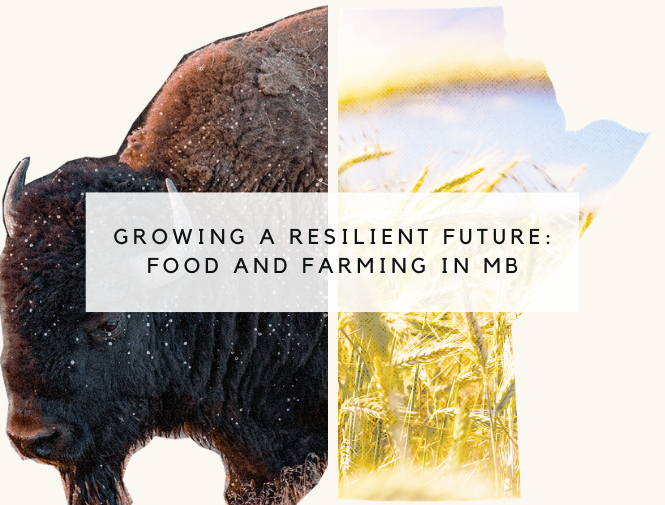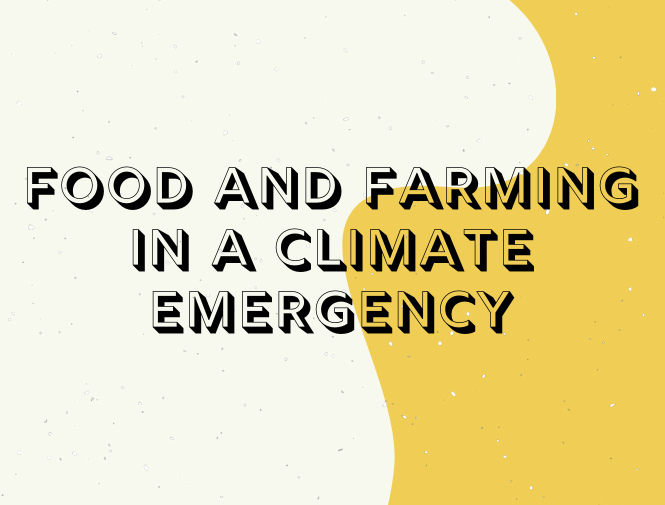
Growing a Resilient Future: Food and Farming in Manitoba
March 18, 2021
Overview
The climate crisis will impact Manitoba farms and food systems, but it is also a chance to restructure and reimagine how we farm and feed our province. In the second webinar in this series, hosted by the Canadian Centre for Policy Alternatives – Manitoba Office, the National Farmers Union, the Manitoba Eco-Network, Manitoba’s Climate Action Team, and the Winnipeg Food Council, each presenter was asked to respond to the question, ‘what do we need to do to reduce greenhouse gas (GHG) emissions and make our food and farming systems more resilient?’
Why is this important in Manitoba?
Over 40% of GHG emissions in Manitoba come from the food and farming sector (including agriculture, agricultural fuel use, and the manufacturing of agricultural inputs), which is a higher percentage than any other province or territory in Canada (Government of Canada 2018). Organizations and individual producers are already creating alternatives to the conventional agricultural system which, if adopted on a broader scale, would greatly reduce the province’s GHG emissions. Unfortunately, government policies and funding programs favour the conventional model, and few incentives exist to encourage a large-scale transition to a more resilient food and farming system in our province.
Speakers
Asha Nelson, Project Coordinator for Fireweed Food Coop, spoke about how the Coop is helping to build a regional local food economy, by connecting small regenerative producers and primarily Winnipeg-based consumers. She explained that in order to increase the market share of local food which currently amounts to just 12% of food purchases in the city, collective infrastructure and robust distribution channels are needed. Initiatives also need to address the affordability and accessibility of local food, ensuring that low-income people have the means to be a part of the solution too.
Julie Price, who works at Northern Manitoba Food, Culture, and Community Collaborative, explained how the Collaborative works to advance food systems and sovereignty in partnership with communities across the North. Historically, Indigenous food systems and sovereignty, including Indigenous farming practices, were intentionally kept at a subsistence level, through policies put in place by the Government of Canada. Many communities now experience extreme food insecurity, and rely upon vulnerable supply chains, to bring commercially produced food from the South. Julie provided a number of examples of how Indigenous communities are reclaiming their traditional food and farming practices, increasing local food production, and growing food sovereignty in Northern Manitoba.
Anastasia Fyk, National Farmers Union board member, is a grain and oilseeds farmer near Garland, Manitoba. In her presentation, she explained that we could virtually eliminate food waste by addressing overproduction, committing to eating locally produced food, and ensuring surplus food is used to address food insecurity in our province. She pointed out that if farmers implemented the 4R method of fertilizer application: the right time, the right rate, the right placement and the right product formulation, the use of GHG-emitting agricultural inputs would be drastically reduced. She also called on the Government of Canada to establish a Canadian Food Resilience Agency to take the lead role in agricultural adaptation and emissions mitigation.
Neil Galbraith, Keystone Agricultural Producers board member, farms grain, oilseeds, and pulses, near Minnedosa, Manitoba. He outlined what some farmers are already doing to mitigate risks to the environment caused by agriculture, including the implementation of Environmental Farm Plans, and the 4R method of fertilizer application. He identified opportunities to reduce fertilizer use, through variable rate applications which reduce fertilizer applications based on key aspects of a landscape’s topography. He also noted a number of other emerging technologies and techniques which would contribute to more resilient farming practices, such as crop rotation, rotational grazing, and the use of alternative fuels.
Duncan Morrison, Executive Director of the Manitoba Forage and Grassland Association, discussed regenerative agriculture, a philosophy and a broad suite of practices, all with the intent of building healthy soil. He explained that perennial production could help farmers reduce GHG emissions by cutting back on annual plowing, by planting more cover crops to maintain the soil, and through the reduced use of synthetic fertilizer and pesticides. All of these have a goal of boosting production with a smaller carbon footprint. He also noted that modern farmers are building larger networks, conducting more outreach and direct marketing, and becoming university educated at an greater rate.
Laura Rance, long-time journalist who writes on agriculture, food and rural issues, acted as moderator for the event.
Key Questions
Our wetlands have been drained, reducing natural environmental benefits. Is it reasonable to depend on temporary grant payments to hold on to remaining wetlands? Do we need a more structured way to deal with environmental management?
There are a number of conservation agreements available through groups like Nature Conservancy and Manitoba Habitat Heritage Corporation, that protect wetlands in perpetuity. There is starting to be more money for that, but there needs to be more incentives for farmers. Farmers care about their fields. They aren’t necessarily thinking about the long-term. There needs to be more incentives and more rules. Right now, people are doing what they want to do with their land, and they have the right to do that.
The United Nations International Panel on Climate Change Special Report on Global Warming of 1.5 degrees Celsius states that we must eliminate fossil fuel use by 2050. Why does Canada’s agricultural sector not have a plan to be compatible with these objectives?
Farmers need government support to transition to these alternatives. They need a framework laid out to meet these objectives. This is why the National Farmers Union has been pushing governments to put money into something like a Canadian Food Resilience Agency, and to put money into agricultural supports so that they can transition into these sustainable practices without it meaning that farmers have to take on that financial risk alone.
How could organic agriculture play a role? Since it is the only federally recognized and regulated sustainable agricultural practice, could it play an important role in facilitating change?
Organic certification has its pros and cons. It is difficult to transition from conventional to organic systems because there is a three year gap in which you are using organic practices but you are not being paid organic prices. It’s a big financial hit and the farmer has to be very well-prepared. Also, organic farming isn’t easy. Organic farming generally uses a lot more mechanical tilling, so even though you are not using any inputs, you are using a lot more fossil fuels to work the tractor. It can be a lot more intensive. If we all, as farmers, moved towards agroecological practices, we would all come at it like a wave and all transition together, to a system that is working with nature rather than against it.
Further Information
Fireweed Food Co-op
Northern Manitoba Food, Culture and Community Collaborative
Keystone Agricultural Producers
National Farmers Union
Manitoba Forage and Grassland Association
Imagine If: A Vision of a Near-Zero-Emission Farm and Food System for Canada – National Farmers Union (report)
A Down Payment for a Resilient Farm Future: Budget 2021 Recommendation – Farmers for Climate Solutions (report)
Road to Resilience – Manitoba’s Climate Action Team (report)

Food and Farming in a Climate Emergency
November 19th, 2020
Overview
The climate crisis will impact Manitoba farms and food systems, but it is also a chance to restructure and reimagine how we farm and feed our province. In the first webinar in this series, hosted by the Canadian Centre for Policy Alternatives – Manitoba Office, the National Farmers Union, the Manitoba Eco-Network, Manitoba’s Climate Action Team, and the Winnipeg Food Council, presenters discussed the role our food and farming sector plays as a contributor to climate change, and opportunities for the sector to do things differently.
Why is this important in Manitoba?
The UN Emissions Report Card 2019 found that we are now on track to warm by 3.2 degrees globally this century. Since continental interiors warm at twice the rate of the planetary average, Manitoba is on track to hit 6.4 degrees. While agriculture and food processing are important to Manitoba’s economy and contribute to about 7% of Manitoba’s GDP (Government of Manitoba 2019), emissions from agriculture, agricultural fuel use, and the manufacturing of agricultural inputs make up over 40% of all emissions in Manitoba, which is the highest percentage in Canada (Government of Canada 2018). If Manitoba is to reduce emissions overall, it must reduce emissions from agriculture.
Speakers
Darrin Qualman, director of Climate Crisis Policy and Action for the National Farmers Union, provided an overview of the climate crisis globally and in Manitoba, explained why agricultural emissions matter so much in Manitoba and outlined some ways we could reduce emissions from the food and farming sector, including decreasing the use of nitrogen fertilizer and other inputs, adopting organic and regenerative agriculture methods, and looking for ways to reduce emissions off the farm as well, including in food transport, packaging, and household choices.
Amber McNish shared her experiences working as a farmer at Borderland Agriculture, a farm in Southwest Manitoba which employs regenerative practices in the production of grain and bison, including reduced tillage, increased crop diversity, keeping soil covered, maintaining a living root, and integrating livestock. By adopting regenerative agriculture, farmers like Amber are not only making an effort to be better stewards of the land, they are also finding that improved soil health is leading to higher yields.
Jeanette Sivilay, coordinator of the Winnipeg Food Council, explained that while large agribusiness and corporate farms have replaced the family farms of the past, 9.1 % of Manitoba households are food insecure (Winnipeg Regional Health Authority 2019). Wealth has been centralized in the sector, and the average Manitoban is less connected to the sources of their food than ever before. Some solutions she presented to encourage a more socially just and climate resilient food system are buying local and eating within your food shed, community food production including community gardens and food cooperatives, and food accessibility and affordability initiatives.
Molly McCracken, director of the Manitoba office of the Canadian Centre for Policy Alternatives and member of Manitoba’s Climate Action Team, acted as moderator for the event.
Key Questions
What makes Manitoba the leader in agricultural emissions compared to Saskatchewan?
It is twofold. Agriculture is just a big part of what the province does, but the other thing, which is actually the ‘good news’ part of this, is that parts of the province do not generate a lot of emissions. One of the reasons that Saskatchewan’s emissions from agriculture appear lower, is that there are a lot of emissions from other sources, one of them being coal-fired power plants. Manitoba is lucky in that way, to rely on hydroelectric power.
Is it a coincidence that agricultural inputs have increased at the same time as farmers were told they were a business and not a lifestyle?
Agricultural inputs have increased for a lot of reasons, and the industrialization is part of it, but also agriculture, like so much of the economy, was restructured. It used to have a basis in biology and now it is in industry. It used to be solar powered in that the people and the horses ran on crops grown from the sun, and then it became fossil-fuel powered. This same shift has happened throughout so much of our economy and society.
What is grain intercropping and how does adopting the practice reduce the need to use nitrogen fertilizer?
Intercropping is a multiple cropping practice that involves growing two or more crops in proximity. Plants that fix nitrogen in the soil are grown, such as peas and legumes. This can reduce or eliminate the use of nitrogen fertilizer because those plants naturally cycle nitrogen and feed the other crops which are being harvested.
Further Information
National Farmers Union
Borderland Agriculture
Winnipeg Food Council
Tackling the Farm Crisis and the Climate Crisis – National Farmers Union (report)
A better future starts on the farm: Recommendations for recovery from COVID-19 in Canadian agriculture – Farmers for Climate Solutions (report)

